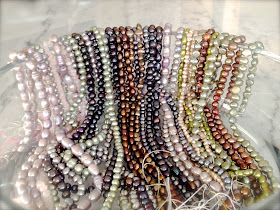-->
Pearls: freshwater and saltwater
Pearls fit into two categories: freshwater and saltwater. As their name implies, freshwater pearls are formed in freshwater mussels that live in lakes, rivers, ponds and other bodies of fresh water. By contrast, saltwater pearls grow in mollusks that live in the ocean.
I have to send a special thank you to Lynn of Urban Pearl Studio on Etsy.com for finding me these beauties. I can't wait to see what they will become.
Urban Pearl Studio is THE go to for handmade artisan wedding jewelry, from pearl strands, to earrings; multi-strand necklaces and bracelets with gorgeous gemstone box clasps, and so much more.
Lynn has another shop where you can source out your own gemstones, TexasBeadz, or purchase more of her wonderful artisan gemstone jewelry at BeadzNBling, also on Etsy. Thank you again, Lynn, for finding me these gorgeous pearls!
Natural
pearls are those pearls that are formed in nature, more or less by
chance. Cultured pearls are those in which humans lend a helping hand,
such as in China’s dominating freshwater pearl farms. Today more than
99% of all pearls sold worldwide, both fresh water and salt water, are
cultured pearls, "designed" from the start to be primarily flawless.
The Different Types of Pearls
 Akoya Pearls are the pearls most people think of when they think of pearls. Perfectly round, gleaming and lustrous, white Akoya pearls were the very first cultured pearls available anywhere in the world. The classic look still reigns today as the definitive standard of the pearl industry. Akoya pearls are saltwater pearls from both Japan and China, and generally range in size from tiny 2.0-3.0mm seed pearls to the largest and rarest 9.5-10.0mm sizes.
Akoya Pearls are the pearls most people think of when they think of pearls. Perfectly round, gleaming and lustrous, white Akoya pearls were the very first cultured pearls available anywhere in the world. The classic look still reigns today as the definitive standard of the pearl industry. Akoya pearls are saltwater pearls from both Japan and China, and generally range in size from tiny 2.0-3.0mm seed pearls to the largest and rarest 9.5-10.0mm sizes.
 Black Tahitian Pearls are rare black pearls from French Polynesia, shimmering with vibrant overtones that are unmistakable and unforgettable. Popular overtones include Peacock, which is a green-gold mix tinged with rose, to Aubergine or deep eggplant; silver and steel tones, and aquamarine or shades of blue-green, all laid over a palette of dove and dark charcoal greys..
Black Tahitian Pearls are rare black pearls from French Polynesia, shimmering with vibrant overtones that are unmistakable and unforgettable. Popular overtones include Peacock, which is a green-gold mix tinged with rose, to Aubergine or deep eggplant; silver and steel tones, and aquamarine or shades of blue-green, all laid over a palette of dove and dark charcoal greys..
Traditionally ranging from 8.0mm up to 16.0mm in size, their glamorous sizes, combined with their unique, naturally-occurring range of greys and blacks make these pearls very desirable.
South Sea Pearls: large and luminous in white and golden from Australia and the Philippians are the largest and rarest of all cultured pearl types in the world. Pearls cultured in the Pinctada maxima saltwater oyster, which can grow up to a foot in diameter at maturation, routinely obtain sizes that range from 9.0mm up to an astonishing 21.0mm! The pearls’ golden and white colors are completely natural, needing no dyes or artificial enhancements.
Cultured South Sea pearls are also known for their soft, satiny glow which is due to their thick nacre layers, acquired through as much as 4 years’ cultivation time. Gorgeously glowing. They truly draw me in.
freshwater
Freshwater pearls come in a variety of colors and shapes to suit every taste, occasion, and budget; from perfectly round, gem-quality pearls to cute button-shapes. Known for their natural pink, lavender and classic white hues, freshwater pearls are an affordable choice that brings the beauty of pearl jewelry to many, without sacrificing quality.
Fresh water pearls are usually dyed or irradiated and it is not difficult to tell whether a pearl's color is natural. There is even a tutorial in Fire Mountain Gems on how to dye your own freshwater pearls!
There are several different types of Freshwater Pearls that you may be familiar with:
 |
| Biwa Pearls |
The most famous type of freshwater cultured pearl is the Biwa pearl which used to come from mussels grown in Lake Biwa, Japan’s largest freshwater lake which is now polluted. These grow to become what we know as “stick” pearls
Keshi (sometimes spelled Keishi) Pearls ( my favorites)
Keshi (in Japanese it means "poppy seed") may be salt or freshwater and are sub-products of the pearl. Basically, pearl garbage. When the oyster rejects a nucleus or a pearl, the fragments of epithelium may yield keshi, baroque-shaped pearls of small diameter which have no nucleus. Keshis come in different size, shapes and coloration.
 |
| Mother of Pearl |
Mother of Pearl is the iridescent substance that forms the lining of the shells of some fresh-water and some salt-water mollusks. Mother of Pearl jewelry is made from the inside part of the oyster shell. Like the pearl it is a secretion of the mantle, (nacre). Among the chief sources are the pearl oyster, found in warm and tropical seas, chiefly in Asia; freshwater pearl mussels, which live in many rivers of the United States, Europe, and Asia; and the abalone of California, Japan, and other Pacific regions.
To learn more about pearls, how they are made, their role in history, how they are graded, etc. there is a beautiful exhibit, full of really interesting info. at the online site of the American Museum of Natural History-online .
Here is a hint of what will be coming from those lovely pearls I got from Lynn.
everyone loves pearls!
Don't for get to scroll down for some JET Pearls!
Thanks for reading,
































